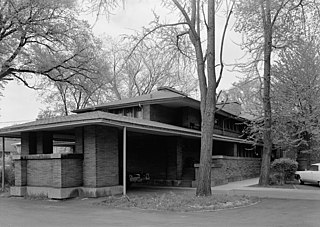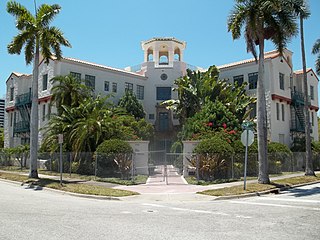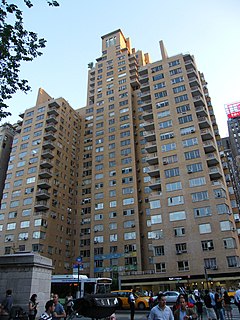
The Darwin D. Martin House Complex, also known as the Darwin Martin House National Historic Landmark, was designed by Frank Lloyd Wright and built between 1903 and 1905. Located at 125 Jewett Parkway in Buffalo, New York, it is considered to be one of the most important projects from Wright's Prairie School era, and ranks along with The Guggenheim in New York City and Fallingwater in Pennsylvania among his greatest works.

The Dunbar Apartments, also known as the Paul Laurence Dunbar Garden Apartments or Dunbar Garden Apartments, is a complex of buildings located on West 149th and West 150th Streets between Frederick Douglass Boulevard/Macombs Place and Adam Clayton Powell Jr. Boulevard in the Harlem neighborhood of Manhattan, New York City. They were built by John D. Rockefeller, Jr. from 1926 to 1928 to provide housing for African Americans, and was the first large cooperative aimed at that demographic. The buildings were designed by architect Andrew J. Thomas and were named in honor of the noted African American poet Paul Laurence Dunbar.

Lafayette Park is a historic urban renewal district east of Downtown Detroit and contains the largest collection of residential buildings designed by Ludwig Mies van der Rohe. The northern section planned and partially built by Mies is listed in the National Register of Historic Places. In 2015 it was designated a National Historic Landmark District. Lafayette Park is located on the city's lower east side directly south of the Eastern Market Historic District. In general, the neighborhood, including portions developed by other architects, has been regarded as an incubator of progressive architecture and one of the few historically stable urban renewal zones in the United States.

The El Vernona Apartments-Broadway Apartments is a historic site in Sarasota, Florida. It is located at 1133 Fourth Street. On March 22, 1984, it was added to the U.S. National Register of Historic Places.
Henry Wright (1878-1936), was a planner, architect, and major proponent of the garden city, an idea characterized by green belts and created by Sir Ebenezer Howard.

Lockefield Gardens was the first public housing built in Indianapolis. Built during the years of 1935 to 1938, it was built exclusively for low income African-Americans in Indianapolis. The complex was closed in 1976, and a number of structures were demolished in the early 1980s. Today, the only original structures remaining are those along Blake Street.

Strehlow Terrace, also called the Terrace Garden Apartment Complex and Ernie Chambers Court, is located at 2024 and 2107 North Sixteenth Street in the Near North Side neighborhood of North Omaha, Nebraska. Designed by Robert Strehlow and reputed local architect Frederick Henninger, Strehlow was added to the National Register of Historic Places in 1986.

Mihran Mesrobian was an Armenian-American architect whose career spanned over fifty years and in several countries. Having received an education in the Academy of Fine Arts in Constantinople, Mesrobian began his career as an architect in Smyrna and in Constantinople. While in Constantinople, Mesrobian served as the palace architect to the last Ottoman Sultan, Mehmed V.

Hilltop Manor is an historic apartment complex located in Bladensburg, Prince George's County, Maryland. The complex consists of eight brick garden apartment buildings, each of which is divided into two to six units or sections, constructed in 1942 and 1943.

The Palmer Park Boulevard Apartments District is a collection of three apartment buildings located in Highland Park, Michigan. The district was listed on the National Register of Historic Places in 1992.

The River Terrace Apartments is an apartment building located at 7700 East Jefferson Avenue in Detroit, Michigan. It was listed on the National Register of Historic Places in 2009. River Terrace Apartments was one of the first two garden apartment complexes built in Michigan which used loan guarantees from the Federal Housing Administration, the other being Hillcrest Village in East Lansing.

The New Hampshire Apartments in Grand Forks, North Dakota were listed on the National Register of Historic Places in 1982. They were built in 1904 at a cost of $26,000 and were significant as a building designed by architect Joseph Bell DeRemer. The apartments were an example of commercial vernacular architecture, and the building was the first in Grand Forks to have a planned second-story-level walkway to another building. When listed on the National Register, the apartment complex was one of few remaining downtown structures designed by DeRemer with classical details. It was built by the Dinnie Brothers, a construction firm that was established in 1881 and was at one time responsible for the building of more than 60 percent of the commercial buildings in Grand Forks.

Fernwood Park Historic District is a national historic district located in the northeast quadrant of Rochester in Monroe County, New York. The district consists of 40 contributing buildings and one contributing site. The garden apartment complex was originally built in 1947 as part of the Rochester Plan to provide quality, low rent housing for veterans returning from World War II and their families. There are 38 two story garden style apartment buildings and one pair of garage units with 36 garages. There are a total of 152 apartments, or four per building, with the buildings grouped in three clusters. The buildings are in a vernacular Colonial Revival style. It is one of three complexes built as part of the Rochester Plan; the others are Norton Village and Ramona Park.

Norton Village Historic District is a national historic district located in the northeast quadrant of Rochester in Monroe County, New York. The district consists of 144 contributing buildings. The garden apartment complex was originally built in 1949 as part of the Rochester Plan to provide quality, low-rent housing for veterans returning from World War II and their families. There are 144 two-story garden-style apartment buildings with a total of 288 two-story apartments, or two per building, with the buildings grouped in four main clusters. The buildings are in a vernacular Colonial Revival style. It is one of three complexes built as part of the Rochester Plan; the others are Fernwood Park and Ramona Park.

Langston Terrace Dwellings are historic structures located in the Langston portion of the Carver/Langston neighborhoods in the Northeast quadrant of Washington, D.C. The apartments were built between 1935 and 1938 and they were listed on the National Register of Historic Places in 1987.

Clifton Terrace are historic structures located in the Columbia Heights neighborhood in the Northwest Quadrant of Washington, D.C. Frank Russell White and Albert Moreland Schneider designed the three building apartment complex in the Colonial Revival style. They were inspired by the garden city movement. Harry Wardman built the complex from 1914–1915 along the 14th Street streetcar line. It was listed on the National Register of Historic Places in 2001.

The Crawford-Tilden Apartments are an apartment building on the eastern side of the city of Cleveland, Ohio, United States. Built to fit an unusual piece of land, it has been named a historic site.

Town Center East is an apartment complex in the Southwest quadrant of Washington, D.C., built in 1960–1961. The twin apartment buildings are across the street from Town Center West; both developments are part of the Town Center Plaza mixed-use development. Town Center East, as well as the plaza as a whole, was designed by I.M. Pei on behalf of William Zeckendorf, who worked with the firm Webb and Knapp.

Linwood Colonial Apartments, also known as Colonial Park Apartments, is a historic garden apartment complex and national historic district located at Indianapolis, Indiana. It was built in 1937–1938, and consists of three three-story, Colonial Revival style red brick buildings. It has 106 apartments and includes a "U"-shaped building and two stepped plan buildings.

240 Central Park South is a residential building in Midtown Manhattan in New York City. Designed by Albert Mayer and Julian Whittlesey, it was built between 1939 and 1940 by the J.H. Taylor Construction Company, an enterprise of the Mayer family. 240 Central Park South is designed in a combination of the Art Deco and Moderne styles, with over 300 apartments.




















